Fluxor
Harmless

Posts: 24
Registered: 18-7-2009
Member Is Offline
Mood: No Mood
|
|
temporary backyard storage
Greetings fellow amateur chemists:
A quick bit of background:
Although up until two months ago my knowledge of general chemistry was essentially zero (still is), I've been reading the threads here and books
constantly. I had a chemistry set as a child (mid-70s) and have had a long-standing love of chemistry which only now I'm in a position to develop
into a seirous hobby. I can't stop reading everything I can get my hands on from the internet and books. A long-standing interest in chemistry has now
become an all-consuming passion. Now I'm at a point in life where I'm able to reconnect with it. I am planning to build a proper lab on a piece of
land I bought in a rural area. But for the moment, I just have the backyard at my house and a few oxidizers and interesting chems to perform
experiments with. Well that's enough about me. Here's my question:
Do you think the old barbecue grills in my backyard (see photos) be a good temporary storage for a few chems? I plan on performing experiments outside
in the backyard, anyway, not far from the barbecue.
I need to store: KMnO4, Ammonium dichromate, H2SO4, and HCL.
I plan to store these inside the unit. The oxidizers in one barbecue, the acids in the other. The copper tubing from the basement has been phsycially
disconnected, so there is no gas line to the barbecue at all. General storage chems I'll keep in the garage.
The advantage of the barbecue is that:
1. It's close to where I will do experiments (backyard).
2. Barbecue looks old and in disrepair, so it is safe to store, no one (neighbors, guests) suspect chems to be there.
3. It is protected from rain and sunlight and has some ventilation.
My main concern right now is 1) moisture and 2) fumes from acid or dust from powdered salts possibly infiltrating into house through window above
barbecue (see photo). No rain gets inside, but moisture does, as you can see by the rust on the top of the mineral spirits can that I've kept there
for about a year. I'm thinking of storing the chems in a small HDPE tub inside each barbecue.
What about a dessicator bag inside the HDPE tub?
Is this a good idea overall? Any disadvantages to the barbecue that you see? Suggestions for good storage?
I'd prefer to store my chems in the basement, but there is a possible ignition source there (gas furnace). Also, I do not want to store ammonium
dichromate inside my house (cancer, mutagen).
Any suggestions are very well appreciated!
Thank you!
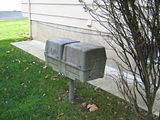
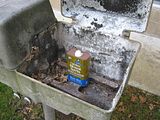
[Edited on 6-12-2009 by Fluxor]
[Edited on 6-12-2009 by Fluxor]
|
|
|
kclo4
National Hazard
   
Posts: 916
Registered: 11-12-2004
Location:
Member Is Offline
Mood: No Mood
|
|
You wont be able to store much there, and I can imagine it would be pretty easy for someone, such as a kid, to just randomly open it.
Temperature would change a lot, and to me it just seems like a bad place to store it, but if it is your only option - well, then I guess you'd be
stuck with it.
What about buying a tiny little shed?
|
|
|
Fluxor
Harmless

Posts: 24
Registered: 18-7-2009
Member Is Offline
Mood: No Mood
|
|
You're right. It's a small space. But I just put my first chem order in from hometrainingtools, so all containers are only
30g, the acids are in small quantity bottles.
The chance of a kid randomly opening it is a concern, yes.
Though it is winter now where I live and not that many kids are out and
about as during rest of year.
Wouldn't the temperature changes be a problem with a shed too?
The shed sounds like a good solution, and I don't really like the barbecue idea because everytime I open the lids to get a chem, it will look strange
and could arouse suspicion of neighbors (the backyard patio area where I will perform the experiments will be obscured by shrubs which I intend to
plant soon).
The only concern I have with the shed is ventilation. I suppose a small shed with windows would be enough. Your thoughts?
|
|
|
Fluxor
Harmless

Posts: 24
Registered: 18-7-2009
Member Is Offline
Mood: No Mood
|
|
Okay, I found this from lowes:
http://www.lowes.com/lowes/lkn?action=productDetail&prod...
it's tiny, you can put a shelf in it, and has a padlock hasp to secure the doors. However, ventilation may be a problem.
|
|
|
kclo4
National Hazard
   
Posts: 916
Registered: 11-12-2004
Location:
Member Is Offline
Mood: No Mood
|
|
That seems like a much better option in my opinion, and I would think a ventilation system, if its really needed, could be rigged up fairly easily -
holes in the side of it, covered partially to avoid getting rain and other crap in it, perhaps?
|
|
|
woelen
Super Administrator
        
Posts: 8012
Registered: 20-8-2005
Location: Netherlands
Member Is Offline
Mood: interested
|
|
The salts like KMnO4 and (NH4)2Cr2O7 can best be stored just inside a dry place like a shed, or even inside the house. These dry salts do not give off
any fumes at all. Sulphuric acid also does not give off any fumes, so I also would store that in a dry place in a shed, or in the house. HCl is
another matter. That does give off fumes and metal pieces will get rusty and dirty very quickly when near a container of HCl, especially when the
weather is cold and humid. So, you could store the HCl in a plastic container, which in turn is stored in the old barbeque. The other chemicals I
would not store at that place.
Experimenting with the ammonium dichromate must not be done inside, this chemical is a carcinogen and you might contaminate the house with dust
particles of this chemicals. So, you can safely (and preferrably) store this chemical inside, but experimenting must be done outside.
|
|
|
Fluxor
Harmless

Posts: 24
Registered: 18-7-2009
Member Is Offline
Mood: No Mood
|
|
Quote: Originally posted by kclo4  | | I would think a ventilation system, if its really needed, could be rigged up fairly easily - holes in the side of it, covered partially to avoid
getting rain and other crap in it, perhaps? |
This sounds good. I may do this for the HCL, as woelen suggested.
Thank you for your help.
|
|
|
Fluxor
Harmless

Posts: 24
Registered: 18-7-2009
Member Is Offline
Mood: No Mood
|
|
Quote: Originally posted by woelen  | The salts like KMnO4 and (NH4)2Cr2O7 can best be stored just inside a dry place like a shed, or even inside the house. These dry salts do not give off
any fumes at all. Sulphuric acid also does not give off any fumes, so I also would store that in a dry place in a shed, or in the house. HCl is
another matter. That does give off fumes and metal pieces will get rusty and dirty very quickly when near a container of HCl, especially when the
weather is cold and humid. So, you could store the HCl in a plastic container, which in turn is stored in the old barbeque. The other chemicals I
would not store at that place.
Experimenting with the ammonium dichromate must not be done inside, this chemical is a carcinogen and you might contaminate the house with dust
particles of this chemicals. So, you can safely (and preferrably) store this chemical inside, but experimenting must be done outside.
|
Thank you woelen for pointing this out. I think I will follow exactly these suggestions.
I considered storing the KMnO4 and H2SO4 inside, but wanted all my chems to be stored more or less in one location. But I now realize it is not such a
big inconvenience to go inside the house to get the salts and sulfuric. However, I will store the HCL outside in a mini shed, in a plastic tub, as you
suggested. All experimenting will be done outside.
(BTW you're site is one I have visited often, it is great!).
[Edited on 6-12-2009 by Fluxor]
[Edited on 6-12-2009 by Fluxor]
|
|
|
Magpie
lab constructor
    
Posts: 5939
Registered: 1-11-2003
Location: USA
Member Is Offline
Mood: Chemistry: the subtle science.
|
|
I use a plastic backyard shed to store my bulk sulfuric acid and hydrochloric acid in large plastic overpacks (pails), and all my flammable solvents
in a plastic tub. I also keep my lawnmower, fertilizers, and ladders in that shed. When I make trips to the shed for acids I carry the day use
bottle in a small insulated bucket as overpack.
The oxidizers I keep in my lab in a cabinet in my garage.
Woelen's right about the HCl. It's almost impossible to completely contain. The shed has a small louvered vent for natural ventilation, but it's
really not adequate for the HCl. I think my aluminum ladders and lawnmower are taking a bit of a hit from the HCl - but nothing I can't live with.
The metal solvent cans are rusted too.
I don't lock that shed. You have to make a judgement on how likely it is for some little kid to enter your shed and start messing around. My kids
are adults now.
The single most important condition for a successful synthesis is good mixing - Nicodem
|
|
|
Fluxor
Harmless

Posts: 24
Registered: 18-7-2009
Member Is Offline
Mood: No Mood
|
|
Quote: Originally posted by Magpie  | I use a plastic backyard shed to store my bulk sulfuric acid and hydrochloric acid in large plastic overpacks (pails), and all my flammable solvents
in a plastic tub. I also keep my lawnmower, fertilizers, and ladders in that shed. When I make trips to the shed for acids I carry the day use
bottle in a small insulated bucket as overpack.
The oxidizers I keep in my lab in a cabinet in my garage.
Woelen's right about the HCl. It's almost impossible to completely contain. The shed has a small louvered vent for natural ventilation, but it's
really not adequate for the HCl. I think my aluminum ladders and lawnmower are taking a bit of a hit from the HCl - but nothing I can't live with.
The metal solvent cans are rusted too.
I don't lock that shed. You have to make a judgement on how likely it is for some little kid to enter your shed and start messing around. My kids
are adults now. |
That sounds like a good system to me. I think I'm going to follow it. I just googled the overpacks and I see there are suppliers that sell specialized
ones for spill containment and absorption. Sounds like the way to go.
As far as locking the mini- shed: I need this. My kids are not grown. But I also worry about theft. The backyard adjoins a busy street that is
frequently visited, with cars parked along the side. And at the moment I don't have a fence. My idea is to plant tall shrubbery around the patio
square in the backyard (next to the barbecue) for privacy. The small plastic sheds commonly available at wal mart, etc. are lockable, but the reviews
have stated that the sides can be disassembled from the floor fairly easily, without any tools.
|
|
|
Magpie
lab constructor
    
Posts: 5939
Registered: 1-11-2003
Location: USA
Member Is Offline
Mood: Chemistry: the subtle science.
|
|
Here's what I meant by overpacks. They're just 5-gallon plastic buckets that my son salvaged from work.
I also show the shed. Unfortunately it's not the cheap one at Wal-Mart but the expensive one at Loew's. The side panels are interlocked to each
other and screwed to a metal connection strip which is screwed to the floor.
Putting up some arborvitae as a shrubbery fence is an excellent idea. They'll grow about 1 foot/year. 
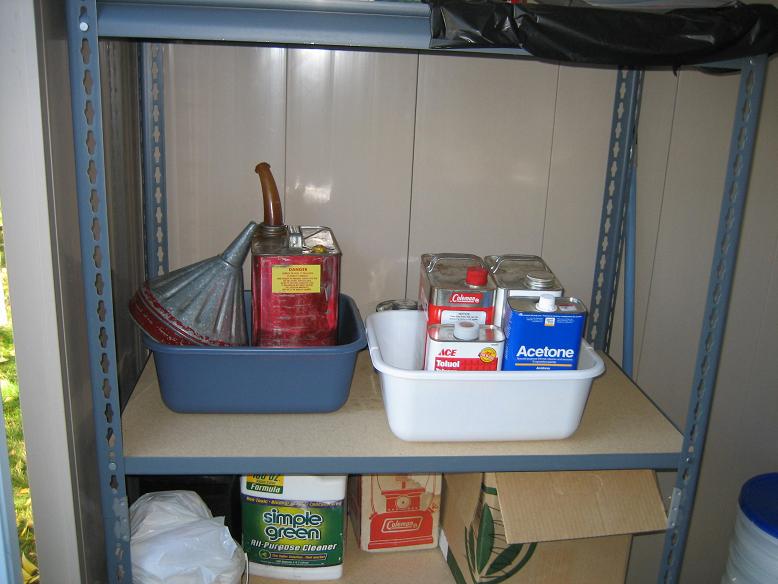
[Edited on 6-12-2009 by Magpie]
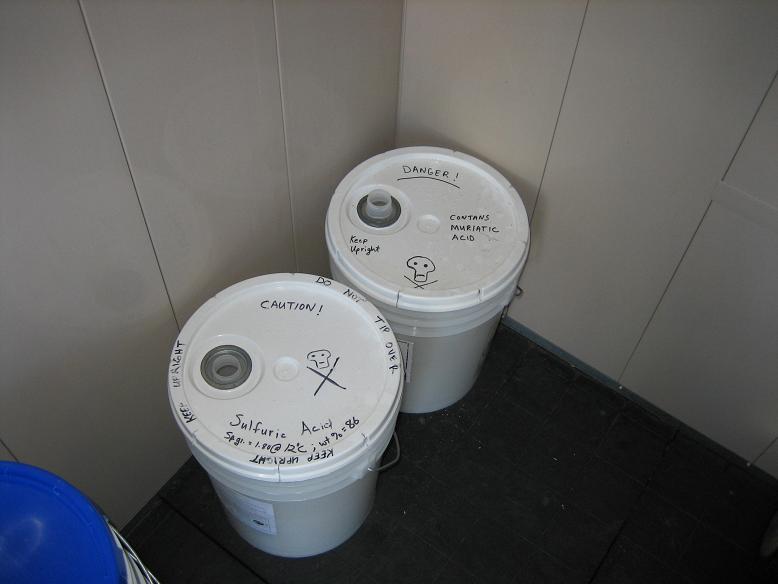
[Edited on 6-12-2009 by Magpie]
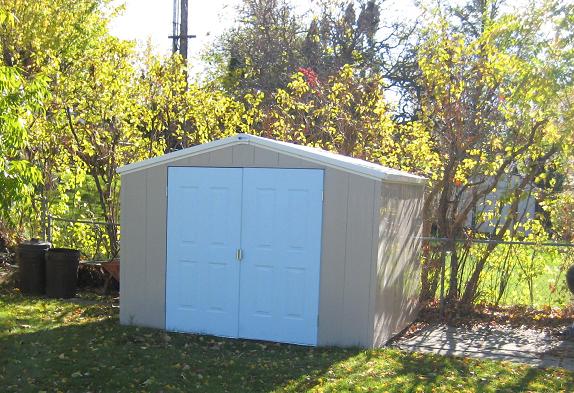
[Edited on 6-12-2009 by Magpie]
The single most important condition for a successful synthesis is good mixing - Nicodem
|
|
|
Fluxor
Harmless

Posts: 24
Registered: 18-7-2009
Member Is Offline
Mood: No Mood
|
|
Magpie...that is sweet I gather it came with the floor, then, if it came with
the connection strip to screw the side panels to. Did you have to lay a foundation? Or did it come together fine right on top of the ground? What
model # is it? ..This may just be what the doctor ordered! I gather it came with the floor, then, if it came with
the connection strip to screw the side panels to. Did you have to lay a foundation? Or did it come together fine right on top of the ground? What
model # is it? ..This may just be what the doctor ordered!
Awesome setup!
Ah, yes, the arborvitae...read my mind, eh?
|
|
|
Magpie
lab constructor
    
Posts: 5939
Registered: 1-11-2003
Location: USA
Member Is Offline
Mood: Chemistry: the subtle science.
|
|
Yes, you buy the floor (8' x 10') separately for a total cost of around $1000. It comes as a kit. You have to put down 4" of gravel for the
foundation. This gravel pad must be perfectly flat. That's the only tough part of the installation. My son and I assembled the building proper in
an afternoon.
It's a Winchester model S010, made by Royal Outdoor Products, a Canadian firm. I've seen them at Home Depot as well as Loew's.
The single most important condition for a successful synthesis is good mixing - Nicodem
|
|
|
Fluxor
Harmless

Posts: 24
Registered: 18-7-2009
Member Is Offline
Mood: No Mood
|
|
Quote: Originally posted by Magpie  | Yes, you buy the floor (8' x 10') separately for a total cost of around $1000. It comes as a kit. You have to put down 4" of gravel for the
foundation. This gravel pad must be perfectly flat. That's the only tough part of the installation. My son and I assembled the building proper in
an afternoon.
It's a Winchester model S010, made by Royal Outdoor Products, a Canadian firm. I've seen them at Home Depot as well as Loew's.
|
Thanks, Magpie.
Will check it out.
|
|
|